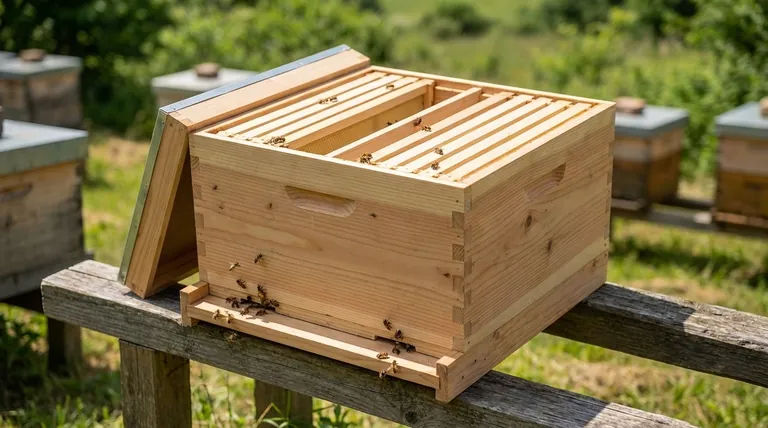In a standard double nucleus (nuc) box, each side is designed to hold exactly four frames. This configuration intentionally creates two small, separate colonies within a single hive body, with a thin central divider separating them.
The core purpose of a double nuc is not simply to house bees, but to function as a specialized tool for beekeepers. Its limited four-frame capacity per side is a deliberate design that creates an ideal environment for raising queens or nurturing new colonies by concentrating the bees' resources.

The Purpose of Limited Frame Space
Understanding why a double nuc is restricted to four frames per side is key to using it effectively. The small size is a feature, not a limitation, designed to help a small bee population thrive.
Promoting Rapid Buildup
A smaller, confined space encourages a new queen to lay eggs in a concentrated pattern. It also allows the worker bees to care for the brood, build comb, and manage resources more efficiently without having to patrol a large, empty area.
Simplified Temperature Control
A bee colony must maintain a stable brood nest temperature of around 95°F (35°C). In a small, four-frame space, the bees can generate and conserve heat with far less effort than in a larger, ten-frame hive body.
Sharing Thermal Energy
The central divider, while keeping the colonies separate, allows for the transfer of heat. This means the two small colonies work together passively, sharing warmth and reducing the energy burden on each individual colony.
How the Double Nuc Design Works
The effectiveness of a double nuc comes from a few simple but critical design elements that allow two independent colonies to coexist.
The Central Divider
The most important feature is the divider that splits the hive body. This ensures each side has its own queen and functions as a distinct social unit.
Separate Entrances
Each compartment has its own entrance, typically located on opposite sides of the box. This prevents bees from drifting between the colonies and ensures a returning queen enters the correct side after a mating flight.
Independent Management
You can manage each four-frame colony independently. One side might be strong while the other is weaker, allowing you to feed or inspect them according to their specific needs without disturbing the neighboring colony.
Understanding the Trade-offs
While powerful, the double nuc is a specialized piece of equipment with clear limitations that must be respected.
Limited Growth Potential
A four-frame nuc is not a long-term home for a colony. A healthy population will quickly outgrow the space, and the beekeeper must be prepared to move the colony into a larger hive.
Increased Swarm Risk
Because space is limited, a rapidly growing colony can become honey-bound or run out of laying space very quickly. This significantly increases the risk of swarming if the beekeeper does not intervene in time.
Not for Honey Production
This equipment is designed for colony propagation, not honey surplus. The population in a four-frame nuc is far too small to gather the significant nectar stores needed for a honey harvest.
Making the Right Choice for Your Goal
Use a double nuc for specific, temporary goals rather than as a permanent housing solution.
- If your primary focus is raising and mating new queens: The double nuc is an exceptionally efficient tool, allowing you to manage two mating nucs in one insulated box.
- If your primary focus is creating small starter colonies (splits): The four-frame capacity provides a perfect environment for a new split to establish itself before being transferred to full-sized equipment.
- If your primary focus is overwintering a small colony: A double nuc can be an effective way to help a small bee population survive winter, especially when the two sides can share heat.
Ultimately, the double nuc's value lies in its ability to support small colonies during their most critical stages of development.
Summary Table:
| Feature | Specification | Purpose |
|---|---|---|
| Frames per Side | 4 | Concentrates bee resources for rapid buildup. |
| Total Capacity | 8 frames (2 colonies) | Efficiently manages two small colonies in one box. |
| Primary Use | Queen Rearing, Making Splits | Creates an ideal environment for new colony development. |
| Key Limitation | Not for Honey Production | Space is too small for surplus honey harvests. |
Ready to boost your apiary's productivity with reliable equipment?
For commercial beekeepers and equipment distributors, a well-designed double nuc box is essential for successful queen rearing and colony management. HONESTBEE supplies durable, precision-crafted beekeeping supplies and equipment through wholesale-focused operations.
Contact HONESTBEE today to discuss your wholesale needs and discover how our equipment can support your most critical beekeeping operations.
Visual Guide

Related Products
- 5 Frame Wooden Nuc Box for Beekeeping
- Automatic Heat Preservation 6 Frame Pro Nuc Box for Honey Bee Queen Mating
- Twin Queen Styrofoam Honey Bee Nucs Mating and Breeding Box
- Styrofoam Mini Mating Nuc Box with Frames Feeder Styrofoam Bee Hives 3 Frame Nuc Box
- Portable Bee Mating Hive Boxes Mini Mating Nucs 8 Frames for Queen Rearing
People Also Ask
- What is a common feature of many 5-frame nuc boxes? The Integrated Feeder for Efficient Colony Growth
- How should the nuc be installed in the apiary? Ensure Colony Success from Day One
- What are the benefits of using nucs for beginning beekeepers? Ensure a Successful First Hive with a Head Start
- How many frames does a typical wooden nuc box hold? A Guide to Choosing the Right Size
- What is the purpose of having a nuc in beekeeping? Build a Resilient & Productive Apiary



















